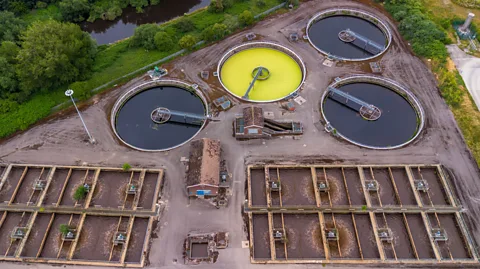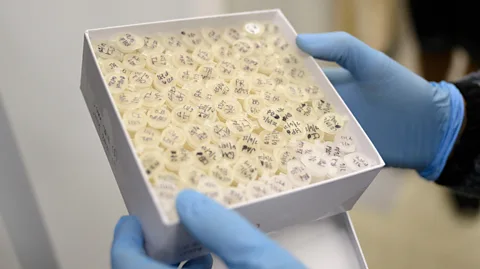How sewers are helping us to monitor disease outbreaks
 Getty Images
Getty ImagesStudying the pathogens in sewage is helping scientists to track outbreaks of infectious diseases – and intervene before they escalate.
When he began his career as a microbiologist, Warish Ahmed never imagined that one of the most critical roles of his career would have involved sifting through litres of raw sewage collected from pipes and manholes across the state of Queensland in Australia.
"Dealing with wastewater might not be everyone’s favourite job," says Ahmed, a principal research scientist at The Commonwealth Scientific and Industrial Research Organisation (CSIRO) Environment in the city of Brisbane. "But I see it as a valuable way to learn about community health. It's like finding liquid gold," he says.
So-called wastewater surveillance has long been used as a crucial way of tracking a small collection of deadly pathogens such as poliovirus, Vibrio cholerae, the bacteria which causes cholera, and Salmonella typhi, the bacteria which causes typhoid fever, all of which are spread through poor sanitation practices.
But more recently, particularly in the wake of the Covid-19 pandemic, public health authorities around the world have begun to realise that studying the material present in sewage can utilised to keep an eye on a much wider variety of infectious diseases, in real time.
The project carried out by Ahmed and his team, in collaboration with the University of Queensland, examined the levels of various respiratory pathogens such as influenza, SARS-CoV-2, which causes Covid-19, and RSV. All these microorganisms are excreted via the guts of infected individuals, and end up in wastewater collected from across the state. RSV is of particular interest due to the high mortality rates it causes among the elderly, especially those with pre-existing heart and lung conditions.
It is not merely the presence of a particular pathogen which interests researchers, but the concentration. "Concentration is highly valuable for tracking the rise or decline of diseases," says Ahmed. "Elevated concentrations of a viral particle may suggest increased viral shedding in the community," he says.
When it is fed back to public health units in the region, this information acts as a key early warning mechanism that a particular infectious disease is spiking in prevalence. And now new technology platforms are making the data ever more efficient to collect.
 Getty Images
Getty ImagesTraditionally, wastewater surveillance has involved the unpleasant and dangerous job of manually collecting samples. But in Queensland, each sewer is now equipped with an autosampler which gathers samples hourly over a 24-hour period. These are then blended together to produce a mixture which can be analysed in special facilities using PCR tests – a molecular technique that can be used to identify fragments of genetic material. In the US, the Centers for Disease Control and Prevention now runs a national wastewater surveillance system to regularly test for a variety of pathogens, including monkeypox, using technology provided by Alphabet-owned Verily.
Other start-ups like the MIT-spinoff Biobot are looking to expand wastewater surveillance across the world through their platform which can not only detect respiratory viruses in sewage, but foodborne illnesses like norovirus, as well as the metabolised byproducts of drugs such as cocaine, fentanyl, methamphetamine, and nicotine.
A potential breakthrough
One of the most contagious viruses on the planet is measles, which is currently causing an outbreak in the UK, and has been surging in the US – with 23 cases from December 2023 to January 2024. In the past, scientists have successfully detected fragments of its RNA in sewage. There are not yet any official screening programmes that use this method, but it's thought that in the future it might help to provide an early warning that the virus is circulating.
"With wastewater you can provide surveillance of cities of millions of people using samples from no more than a few sites," says Joshua Levy, of Scripps Research, a non-profit biomedical institute in San Diego. "You need way fewer samples to meaningfully characterise local pathogen dynamics, compared to costly and high-volume nasal swabs or blood draws which are often quite biased by disease severity. Instead, asymptomatic infections are still detected by wastewater."
Boosting health security of low-income nations
While wastewater surveillance is being used extensively in the US, Australia and also the UK, where an ongoing programme is using sewage sampling to identify areas of the country at higher risk of polio, its biggest impact of all is likely to be in managing disease outbreaks in low-income nations.
Representatives of PolioPlus, Rotary International's global initiative to eradicate polio, point out that while polio incidence has been reduced by 99.9% over the past 35 years, it remains a major public health problem in Pakistan and Afghanistan where poliovirus is endemic.
"In Pakistan there are 114 wastewater surveillance sites and in Afghanistan there are 33," says Carol Pandak, director of PolioPlus. "Without surveillance it would be impossible to pinpoint where and how poliovirus is still circulating."
 Getty Images
Getty ImagesOn the other side of the globe, monitoring sewage is proving to be a vital tool for the São Paulo municipal government in its ongoing battle against the hepatitis A virus (HAV), an infection which causes inflammation of the liver and sometimes requires a liver transplant.
In recent years, São Paulo has had two large HAV outbreaks with 1,872 confirmed cases between 2016 and 2023. According to Tatiana Prado, a virologist at the Oswaldo Cruz Foundation, a research institute in Rio de Janeiro, the city has implemented a continuous sewage surveillance program at some airports and risk areas to monitor for new emergences of HAV as well as other viruses and bacteria. She predicts that new technologies will only continue to enhance the information which these programmes can provide.
"New diagnostic tools are emerging which will be able to generate millions of data points about the different types of microorganisms circulating in a given environment," says Prado. "But the biggest bottleneck will be the investments needed to maintain the surveillance systems and interpret all the data generated, so it is useful to policymakers."
Early warnings
With similar programs having been trialled in parts of sub-Saharan Africa for tuberculosis and even parasites such as Cryptosporidium, a cause of diarrhoeal disease, wastewater surveillance will undoubtedly play a growing role in providing intelligence to global health systems on all manner of worrisome pathogens.
In the coming years, researchers hope that real-time surveillance will begin to yield new information on the evolution of many common viruses, enabling them to predict whether they might be in danger of escaping existing vaccine-derived immunity. Such information could then be swiftly fed back to vaccine manufacturers, enabling them to update their jabs before the newly evolved pathogen is more widespread in the community.
"Some researchers have shown that undetected circulation and evolution of common viruses is much more common than previously believed," says Levy. "Work is ongoing to understand the significance of this to major questions in virology such as the emergence of variants of concern.
"It has been shown that we can detect the presence of new viral variants in wastewater 10 or more days earlier than other forms of surveillance, [providing] essential lead time for public health officials and stakeholders to provide guidance, and for members of the public to modify their behaviour if needed," he says.
Similar information could also be used to preserve and protect antibiotics so that they continue working for future generations, by examining sewage samples for the presence of resistance genes – segments of DNA which give a bacteria the capability to survive treatment with certain antibiotics.
Amy Pruden, a professor at Virginia Tech, says that this kind of surveillance could help pinpoint communities which have more of a resistance problem, alerting doctors to potential infections which are spreading among the population and providing them with more information to be able to prescribe the most effective antibiotic.
 Getty Images
Getty Images"An idea that is catching on is the possibility of using metagenomic DNA sequencing," says Pruden. "The beauty of this approach is that it allows you to sequence the DNA from all the bacteria in the sewage at once, then compare it to databases and see what kinds of pathogens likely present, and what kinds of resistance genes they likely carry. There is a lot of potential here, but it is still in the nascent stages of application," she says.
The ultimate hope is that such surveillance efforts could also catch future epidemic outbreaks or even pandemics in the very earliest stages, providing governments with the ability to respond and direct efforts towards vaccines and drug development far faster than before.
Going forwards, Ahmed's team and others around the world are exploring the possibility of analysing the viral content from aircraft wastewater, to track potential new variants of influenza and Covid and possibly even new viruses, which are being transmitted from elsewhere in the world.
"It's crucial to have the necessary tools ready before the next serious virus emerges so that we can effectively combat it," says Ahmed.
--
If you liked this story, sign up for The Essential List newsletter – a handpicked selection of features, videos and can't-miss news delivered to your inbox every Friday.
